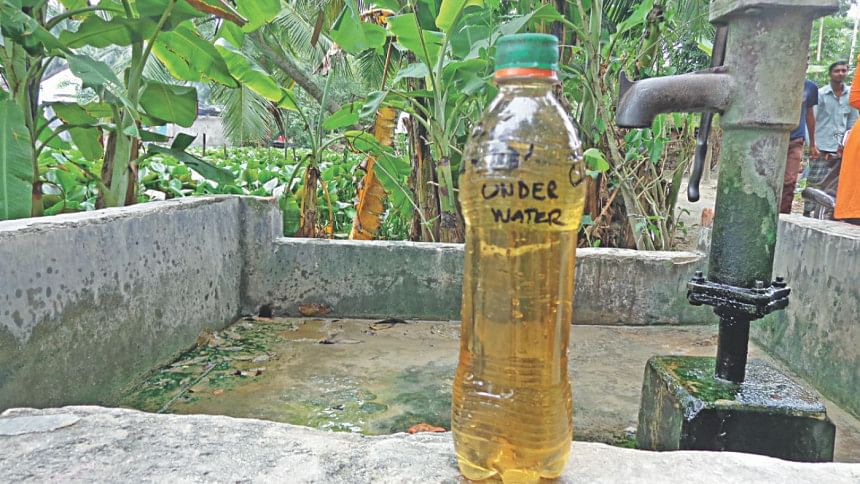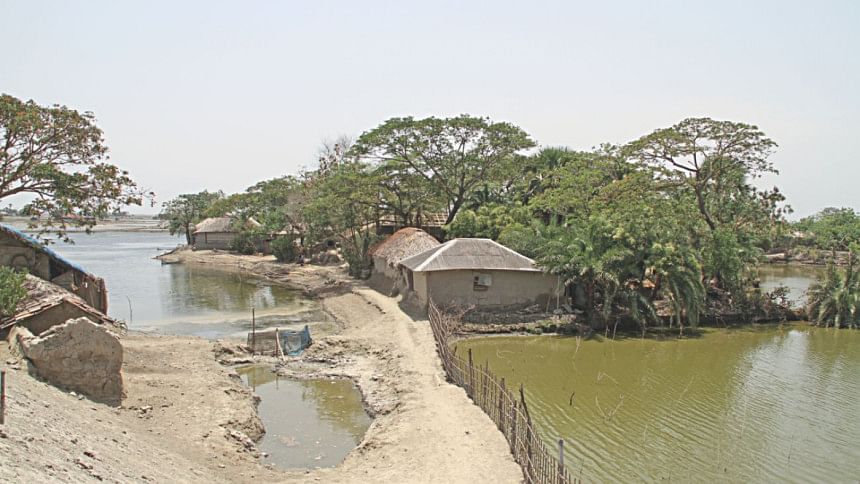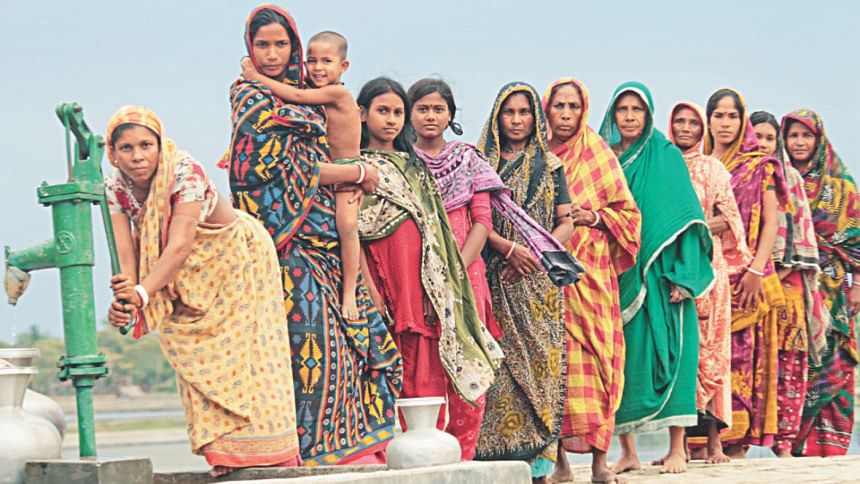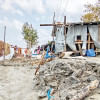The water business in the south west of Bangladesh

There is a district in the south-west of Bangladesh which is at the epicentre of a drinking water crisis. A crisis that is being exacerbated everyday owing to the realities of climate change.
For 26-year old Jesmin Khatun, of Gautamkathi village in Jalilpur, Tala upazila of Sathkhira, the water crisis is one that comes with both financial and physical constraints.
For starters, she has to walk 1.5 kilometres twice everyday to collect fresh drinking water. Not only does she have to walk the distance, but then has to spend money to buy the jars of clean water.
Each jar of clean drinking water costs around Tk 20 and the cost of the van fare, after she walks to the main road from her village, is Tk 10, which means Jesmin's family of six have to spend a whopping Tk 1,500 on water each month.
“My back hurts from having to carry these heavy water jars every day. Because this water is so expensive, we do not dare use this for any other purpose. So, for cleaning and other purposes, we have to use saline pond water,” says Jesmin.
The story of Rupa Khatun of Shahid Ajij Shushil Palli in Jalilpur of the same upazila is much the same. She has to walk around 10 minutes, take a 15-minute van ride and then wait in line for 30 minutes, before getting the water. Added to the extreme physical labour is the economic constraint. Rupa's family has to spend a total of Tk 1,500 on drinking water containing yellowish heavy metal spewed out by the tube-wells in these regions.
Like Jesmin and Rupa, it is the women in the south-west region who are tasked with bearing the brunt of the drinking water crisis.
This story is about some of these people in Sathkhira, who spend a lion's share of their day and consequently their whole lives in search of fresh drinking water; and who are now having to spend hard-earned money on sourcing a basic right. It is about a district, facing rampant industrialisation and the first attack of global climate change.
A district in the clutches of an acute drinking water crisis
A combination of tidal flooding, inundation by storm surges and saltwater intrusion has led to a rise in salinity in groundwater and in fresh-water ponds. As a result, in the coastal area of Sathkhira, potable water is a scarce and precious commodity.
As you roam the south-west zone of Bangladesh and study up on its topographical and hydrological data, you will come to realise the land structure is unlike any other area in the country. So, any standardised plan, such as installing deep tube-wells like in all other parts of the country, will actually not produce any fruitful results in this region. While in many parts of Bangladesh, establishing a deep-water tube-well at a depth of between 300 to 1,200 feet will give you access to water, in Satkhira, that is not the case, says Jahin Shams, programme development specialist at Uttaran, an NGO working in the area.
“As you travel around the villages in most of the upazilas of Sathkhira, you will see there are many deep-tube wells that have been established to ensure drinking water for the villagers but they simply do not work,” says Shahidul Islam, the director of Uttaran and a native of Sathkhira.
Those that work, often spew out yellowish, iron-heavy water. In Tala upazila of Sathkhira, locals have complained of having to drink yellowish and metal-heavy water which they pump out from their tube wells because they cannot afford to buy water that is treated through reverse osmosis or arsenic.
Aminul Islam, executive engineer of the Department of Public Health and Engineering (Sathkhira), says this is because the geological conditions of this area is so different here that even if a tube-well gives clean water for a few months after its construction, the water source soon becomes contaminated.
“The government has set up a few Arsenic Iron Removal Plants (AIRP) and Reverse Osmosis plants (ROP) to treat this water but these have a limited capacity and cannot treat litre upon litre of water. But this treated water is not free of cost. Each litre costs somewhere between 30 paisa to two taka,” says Aminul.
This has also given rise to some private business running ROPs and AIRPs which sell jars of treated water to locals at one taka per litre. Both the economically well-off and the extreme poor have to rely on this which ends up creating a gross inequality in the region and in fact in the entirety of the country.
For example, in many areas of the capital (except for most urban slums), the average cost for month-long (ideally unlimited) water supply is BDT 400. This is meant to cover water used for drinking, laundry, cooking, cleaning and other miscellaneous uses.
Contrastingly, in rural Sylhet, where my aunt lives, the water supply is completely free of cost. Their deep-water tube-well is just a minute's walk and they have a direct supply of water to their house. This means they do not have to spend long hours trying to access water or pay a single taka for it.

Where water comes with a cost
In the coastal areas of Bangladesh, namely Sathkhira, not only is drinking water scarce, it also comes at a much higher cost, than anywhere else in the country.
The government has pledged under goal six of the sustainable development goals (SDGs) to achieve universal and equitable access to safe and affordable drinking water for all by 2030 (section 6.1). Just a decade away from meeting the goal, equitable access to safe and affordable drinking water remains a far cry.
Since drinking water is so scarce in the south-west region and often comes at a price, many locals refuse to use this precious water for any other purpose than drinking.
With the threats of climate change-induced salinity intrusion and shrimp cultivation, freshwater sources are rapidly shrinking in Sathkhira. The water in the ponds and rivers are saline. Left with no other option, locals have to use saline water for sanitation and other purposes (showering, cleaning, laundry) which puts them at risk of skin diseases.
There are also people who cannot afford to buy clean water and have to resort to drinking arsenic, iron or manganese containing water from the tube-wells putting them at risk of high blood pressure.
Higher salinity also means fishing as a source of income is nullified, so is the promise of a good harvest. This means most of these people have no scope to improve their living standards.
This drinking water crisis has exacerbated in the decades since the eighties, when the reserve drinking water ponds constructed during the British era were polluted by saline water due to shrimp cultivation, which gained popularity around that time, says Islam of Uttaran.

Is there a way out?
In terms of coming up with solutions, locals and experts believe a detailed hydro-topological study of the area is required. “The government cannot use the same set of tools that it uses for other areas to ensure water supply here. A newer technology or maybe a more multi-pronged approach could be the answer,” says Islam.
Officials at the Department of Public Health and Engineering (DPHE) say they have been working to solve this crisis since its inception in 1936. So why have their efforts not seen fruition?
“You see, the geological condition in this area is unlike any other place in Bangladesh. We are trying our best to ensure at least one deep tube-well for every 10 families,” says Aminul.
But even if deep tube-wells are established, the water they spew out is not of drinkable quality. This water is then treated through various treatment plants but that increases the cost of the water.
“The government has taken up a scheme to dig up 73 freshwater ponds, to ensure a supply of water for the locals. The work is being done by DPHE and these ponds will be handed over by July 2019,” says Aminul. These ponds are much like the British era ponds we talked about earlier, the very ones that got polluted because of rampant shrimp cultivation and salinity intrusion in the area.
Experts and locals both believe the onus of the task to ensure clean drinking water lies with the government. NGOs or short projects are not the answer to this crisis, because they run on a project to project basis and the water scarcity issue in this region requires long-term planning and work. Especially, now, as the threat of climate change looms closer.
According to a study by the World Bank, river and groundwater salinity is predicted to dramatically increase by 2050 owing to climate change. This will exacerbate shortages of drinking water and irrigation in the southwest coastal areas of Bangladesh, adversely affecting the livelihoods of at least 2.9 million poor people in a region where 2.5 million people are already struggling with a lack of water.
Acknowledgements: Jahin Shams Programme Development Specialist of Uttaran provided the case studies that they are collecting for research for a book.

 For all latest news, follow The Daily Star's Google News channel.
For all latest news, follow The Daily Star's Google News channel. 








Comments